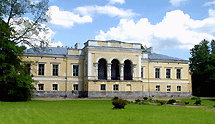Start page

Sitemap




Alphabetical

By parishes and
historical counties

By contemporary
local municipalities




Various meanings
of manor

Types of manors

Manor complex

Estonian manors
|
 |
 |
 |
At the beginning of the 20th century there were eight types of manors:
-
Knight manors
(in German: Rittergut)
were the main type of private manors. The landlords had certain privileges and rights on their land but also obligations to the state. For example, the owners of knight manors who had been entered into the list kept by the local noblemens organisation (knighthood) had a vote in the local government of noblemen. Most of the private manors in Estonia and a great share of the total number of manors (including almost all outstanding
manor complexes)
were knight manors. At different times knight manors have had different size requirements.
-
Semi-manors
(in German: Landstelle)
were private manors that due to their smaller size were not given the status of knight manor and the related privileges. Typically, semi-manors were created by separation from older manors. Some of them were really small only a residence and a park.
-
Church manors
(in German: Pastorat)
belonged to the Lutheran Church and were managed by pastors. They also served as church offices. As a rule they were less prominent than knight manors. Usually
each parish
had its own church manor. It was located near the church, which functioned as the parish centre.
-
State manors
belonged to the state and hosted civil servants who also run the affairs of the manors. They were usually more modest than knight manors or church manors.
-
Support manors
(in German: Beigut)
it sometimes happened that a landlord acquired several close-set manors which then functioned as a joint estate. The landlords usually lived in the most outstanding manor; in the rest (enjoying the status of knight manors) greater emphasis was laid on economic facilities. Such manors were called support manors.
-
Knighthood manors
belonged to the knighthood, i.e. the local government of noblemen. Such manors had often fewer buildings and accommodated managers.
-
Town manors
were owned by municipal governments (earlier: town councils).
-
Manor dairy farms
(in German: Hoflage)
were not independent households but facilities located further away from the manor centre hosting some workers, the cattle or production buildings. They were again very modest compared to the main manors and often temporary. Deciding which facilities belonged to a manor dairy farm was often rather arbitrary. Most of them still formed a building complex that could be regarded as the manor heart.
The classification of manors in this portal relies on Richters address book (1909-1913). In most cases it does not provide information on the status change of manors over time. A note has been made only about those manors that lost their status as a knight manor in the 19th century. The current version of the portal does not include manor dairy farms and parsonages.

|
 |
|
 |
 |






